Matador Network's Blog, page 1073
June 19, 2019
Sommarøy wants to get rid of time

If you loathe the whole concept of Daylight Saving Time, you’ll be in agreement with the good people of this Norwegian Island.
For Sommarøy, an island north of the Arctic Circle in west Tromso, there might soon be no hours in the day at all. The island’s residents are campaigning to completely abolish the concept of time, mainly because time works quite differently on Sommarøy. Since it’s so far north, the sun doesn’t rise there in winter or set in summer, and enacting a “time-free” policy would reflect the inhabitants’ unusual schedules much better and give everyone the possibility to use the endless daylight however they wish.
Kjell Ove Hveding, a Sommarøy inhabitant who spearheaded the Time-Free Zone campaign, told Norwegian radio station NRK, “When you come here, you should be able to throw away your watch and live your life.”
After Hveding presented local MP Kent Gudmunden with a petition on June 13, the Time-Free Zone campaign has gained a lot of public attention. The petition called for a serious discussion of the potential ramifications and benefits of implementing the time-free policy, including putting this remote part of the world on the map for a tourism boost.
“Our goal is to provide full flexibility, 24/7,” said Hveding. “If you want to cut the lawn at 4 AM, then you do it.” 
H/T: Insider

More like this: Mapped: What you did not know about time zones
The post This Norwegian island wants to be the world’s first time-free zone appeared first on Matador Network.

Deerfield Beach divers cleanup

New world records are set all the time, but this particular record-breaking feat is one with a hugely important environmental impact. As part of a mass campaign to clean trash from the waters of Florida’s Deerfield Beach, 633 divers from all over the world took to the ocean on June 15. They retrieved thousands of pounds of trash that had been polluting the reef and ocean floor, and in the process, broke a Guinness World Record for the largest underwater cleanup effort. The dive was organized by Arilton Pavan, owner of the local dive shop Dixie Diver, and the Woman’s Club of Deerfield Beach.

Photo: Project AWARE/Facebook
At least 3,200 pounds of fishing gear and 9,000 pieces of marine debris were retrieved, Project AWARE reported. While this is great news for Deerfield Beach, it’s not so encouraging when considered as part of a larger trend of pollution. Plastic debris was the main source of pollution found, but lead was also found in abundance, as it’s often used in fishing jigs, lures, sinkers, and weights. Lead is incredibly dangerous for wildlife like birds and fish, who can eat wayward sinkers and get lead poisoning.

Photo: Project AWARE/Facebook
While the new world record was indeed gratifying to the team of divers, the primary goal was not the record, but the cleanup itself. Even Guinness itself acknowledged that the record should take a backseat to the results of the cleanup effort. Empric, the Guinness adjudicator, told the South Florida Sun Sentinel, “It doesn’t matter what happens today with the Guinness World Records. What really matters is that everyone out there is cleaning up around the pier and trying to improve the community.” 

More like this: Bali’s beach pollution is getting out of hand. Here’s what you can do.
The post 633 divers join forces in record-breaking ocean cleanup appeared first on Matador Network.

A local’s guide to Venice
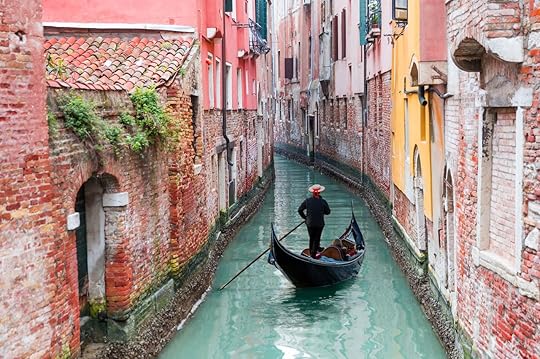
For visitors looking to avoid the crowds in Venice, diversity is the answer. The city groans with tourism all year round, but by changing a few habits and avoiding over-congested destinations, visitors to the city can both aid sustainable tourism and enjoy a more peaceful holiday in Venice. Patronizing local craftsmen instead of made-in-China import shops, seeking out deserted churches down quiet alleys, and heading out into the lagoon are some of the recommendations in this non-tourist guide to Venice to help visitors experience the city from a more local point of view.
Shopping

Photo: upixa/Shutterstock
There’s no need to spend time in anonymous supermarkets when in Venice (though take a peek inside the Despar Teatro located inside an old, refurbished theatre). For food, go to the Rialto markets, which are historical markets serving Venice since the 12th century. At the fish market, you can find local specialties from the lagoon like clams and mantis shrimp. If it’s not too busy, the sellers are usually enthusiastic about sharing recipes and cooking ideas. The fruit and vegetable market next door sells produce which comes from the nearby Sant’Erasmo island, sometimes called the “vegetable garden of Venice.” Both markets have been struggling as the number of residents in the city dwindles, so patronage from visitors to the city is essential to keep them alive.

Photo: Ca’ Macana/Facebook
Souvenir shops are not in short supply in Venice, but quality is hard to find. If you want to take home the symbol of Venice, a mask, go to Ca’ Macana, which only sells handmade, local products. You can also take a workshop here to paint your own. Another historic product of the city, but one that hasn’t received as much fame as masks or glass, is paper. Legatoria Piazzesi is the oldest paper shop in Venice, and it sells hand-printed papers, decorated notebooks and stationery, and even has an in-house bookbinding service.
Sightseeing
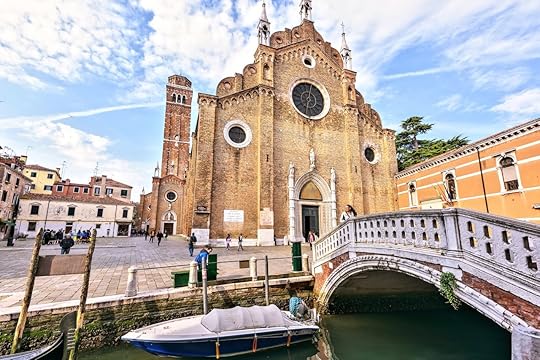
Photo: CastecoDesign/Shutterstock
Venice’s most famous sights are not to be missed, especially on a first trip to the city. The Accademia Gallery and the Palazzo Ducale, for example, are amongst the most prestigious museums in Europe, if not the world. But with increasingly high entrance fees ($17 and $22.50 respectively) and swarms of tourists, if you’re not going to spend five hours studying all the artwork, there are more reasonable and far less crowded options.
The best way to see art at a low cost and without hordes of tourists is to go to churches. One of the richest churches for art is Santa Maria dei Frari which, for a $3.50 entrance free, lets you see Titian’s ”Assumption of the Virgin” altarpiece, an altarpiece by Giovanni Bellini, and a wooden sculpture of John the Baptist by Donatello. The Church of the Carmini is another church that’s free to enter, and houses paintings by Tintoretto, Cima da Conegliano, and Lorenzo Lotto. San Pantalon, again free, is a Baroque extravaganza with a ceiling that holds the accolade of largest single canvas in the world, and San Cassiano is home to a Tintoretto crucifixion which the great art critic John Ruskin honored as the “finest [example of a crucifixion painting] in Europe.”
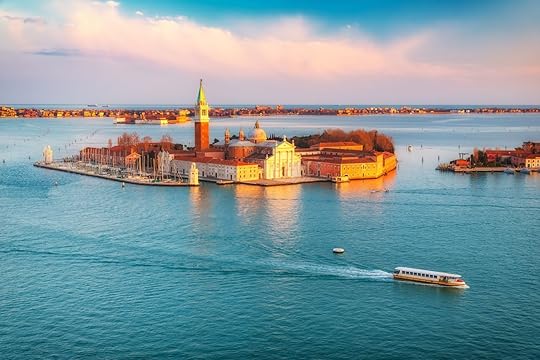
Photo: S.Borisov/Shutterstock
Other money-saving and crowd-dodging tactics include using the public Vaporetto service as your boat tour. The number 1 chugs down the Grand Canal giving you a view of ornate palazzo facades, and a well-timed trip back from the Lido can be used to appreciate sunsets over the city. St. Mark’s bell tower is popular for getting a view of the city stretched out below you, but the bell tower of San Giorgio Maggiore, just across the water from St. Mark’s Square, has a much shorter queue and has a view of Venice in its more poetic aquatic setting instead. The Fondaco dei Tedeschi, a newly opened department store in a refurbished 16th-century building, has a free roof terrace that overlooks the Grand Canal. You just need to book your 15-minute slot online. Finally, it may sound counterintuitive for budgeters, but hotel rooftop bars like that of Danieli provide spectacular views across the lagoon at a cost similar to that of St. Mark’s bell tower but with a fancy cocktail thrown in.
Food
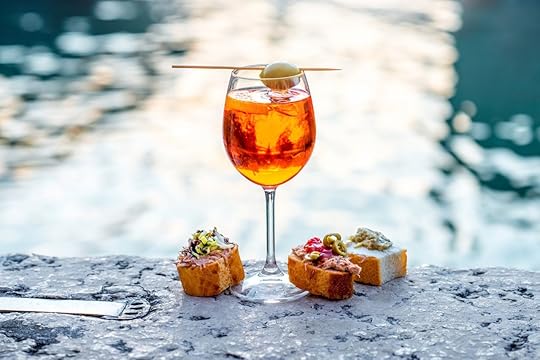
Photo: RossHelen/Shutterstock
Bacari, or local Venetian bars, are the place to try Venetian finger-food specialties, cicchetti. Baccalà mantecato is a creamy mousse made from salted cod which is usually eaten on little pieces of toasted bread or on squares of polenta. Try it at Cantina do Spade, along with sarde in saor, which are sardines with onions, vinegar, and raisins. Bancogiro, near the Rialto, does a whole variety of crostini, toasted bread with toppings like gorgonzola and honey or prosciutto, and has seats on the Grand Canal.
For dinner, look out for places called osterie or trattorie and never be tempted into a restaurant by a waiter-punter on the street. Osteria Ruga di Jaffa, decorated with dark wood and Venetian flags, follows the custom of a counter displaying several plates of fried and grilled seafood from which you can make a mixed plate. On the upper end of the osteria scale, though still reasonably priced for the quality, is Osteria Boccadoro, serving fish from the lagoon or north Adriatic and vegetables from the restaurant’s own garden on a lagoon island.
For breakfast and afternoon coffee, follow the Italian example and stand at the bar to avoid incurring any “seating” charges. Venice has several historic pasticcerie for a breakfast that far outshines that of any hotel, such as Rosa Salva, which has been supplying Venetians with their calorific pastry fix since the 19th century, and Pasticceria Tonolo. A typical breakfast here would be a cappuccino or espresso and a well-filled croissant, rum babà, doughnut, or deep fried frittelle if it’s Carnival time.
Walking routes

Photo: Shevchenko Andrey/Shutterstock
Along with overpriced food, tacky souvenirs, and interminable queues, the overcrowding of Venice’s narrow streets leaves visitors distinctly ruffled. The romance of the dark, labyrinth-like alleys is quickly lost when you’re stuck behind dawdling crowds or poked in the eye by an umbrella. Avoid these streets by heading out to areas like the Fondamenta delle Zattere, a wide promenade running along the Giudecca Canal, which always seems to be blessed by sunshine. There are benches to sit on and look out at the little houses of Giudecca Island or to use as a handy stopping point to eat ice cream from Gelateria Nico.
The Giardini della Biennale, out in the Castello area (the tail of the fish-shaped city), is a surprising oasis of green in a city characterized by alleys and tight-knit buildings. The nearby Serra dei Giardini is a greenhouse-cafeteria housed inside a pavilion originally built to house plants for one of the international exhibitions. Now, it sells plants, hosts art exhibitions, cultural events, and music performances, and has a cafe with organic products.
Heading out into the lagoon is also a way to escape the crowds and find some authentic Venetian culture. On the island of Murano, you can visit the Museo del Vetro, the glass museum, and on colorful Burano, you can find the Museo del Merletto, or lace-making, both of which are historic Venetian crafts.
Accommodation
Accommodation is notoriously expensive in Venice. A room in a Grand Canal hotel can set you back over 500 euros a night. Many are turning to Airbnb for the answer, but sadly that has evolved from its origins as a house-sharing system into a lucrative business, so prices are high but the quality is often shockingly low. The middle ground is to stay in well-established small, family run hotels.

Photo: Ca’ Dogaressa
Ca’ Dogaressa, in the Cannaregio district, has elegant 18th-century Venetian decoration like brocaded walls and Murano glass chandeliers, and rates start as low as $85 in offseason. Close to St. Mark’s Square, Rosa Salva Hotel boasts the rare quality of spaciousness and is part of the historic pasticceria business. Rates start from $100 in the low season rising to $200 come summer. To lower costs further, We Crociferi is a hostel located inside a restored convent. It’s basic, but there is an arcaded cloister and spacious bar where music and culture events often take place. 

More like this: Cicchetti are Venice’s answer to tapas. Here’s where to try them.
The post A non-tourist guide to Venice appeared first on Matador Network.

June 18, 2019
Most beautiful glass ceilings
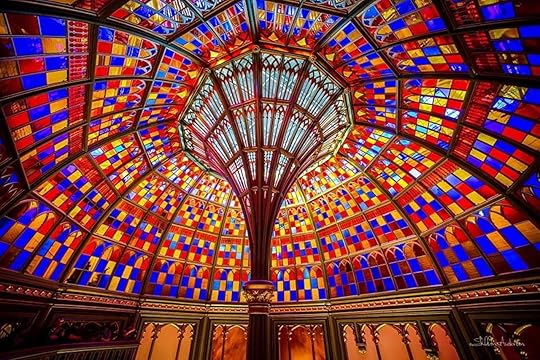
Museums are great and all, but if you’re not the kind of traveler who likes to spend hours shuffling around indoors to see art, alternative options are most welcome. Checking out the architecture of a destination is a freeing way to get a healthy dose of man-made beauty, as well as a history lesson, and is usually very easy on the wallet. Ceilings, in particular, often do more than protect a place from the elements and can be a beautiful medium for art, especially when made of glass. You may strain your neck while checking out these amazing glass ceilings from around the world, but the gorgeous creations resting above your heads will be very much worth it.
1. Cathedral of Brasília — Brasília, Brazil

Photo: edusma7256/Shutterstock
The Cathedral of Brasília in Brazil is home to a unique ceiling, especially in a church. Sixteen curved concrete columns interspaced with stained glass form a circle of light and make for a stunning visual display around the churchgoers, who surely feel transported every time they visit this wonderful structure.
2. Galleria Vittorio Emanuele II — Milan, Italy
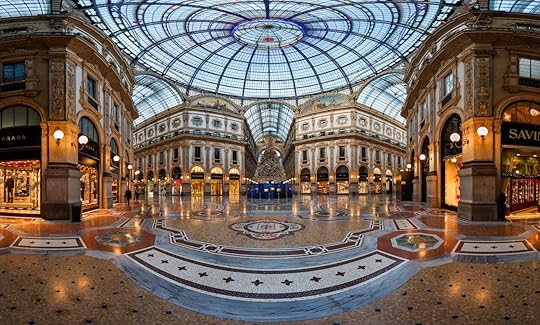
Photo: ansharphoto/Shutterstock
A landmark of Milan — and still an active shopping mall — the Galleria Vittorio Emanuele II treats shoppers not only to luxury stores but also a massive glass ceiling topping the entire arcade-style structure. In the center, a glass dome stands tall as an easily recognizable feature of the classic design, which dates back to the mid-1800s.
3. Wafi Mall — Dubai, United Arab Emirates

Photo: s4svisuals/Shutterstock
Like most things in Dubai, Wafi Mall is over the top. Much more than a mere shopping mall, it’s a spot for fine dining, a health club and spa, glow-in-the-dark mini golf, and even a traditional Arab souk. Towering above it all is an elaborate, multi-colored, pyramid-shaped stained glass ceiling depicting peaceful nature scenes. Another stained-glass pyramid roof elsewhere in the mall shows ancient Egyptian symbols, while a third stained-glass art piece in the mall is a large dome designed with soothing, cool colors that would surely help stressed-out shoppers relax.
4. Hotel Raquel — Havana, Cuba

Photo: Dan Kosmayer/Shutterstock
Havana’s Hotel Raquel dates to 1905. Its 25 rooms are decorated with paintings and pictures by Cuban artists, and the hotel reflects an Art Nouveau style throughout. Besides the stylish interior, however, the biggest eye-catcher in the hotel is the ornate arcade ceiling in the lobby. The colorful stained-glass piece bestows a soft glow on the rooms and halls below; it’s the skylight of all skylights.
5. National Gallery of Victoria — Melbourne, Australia
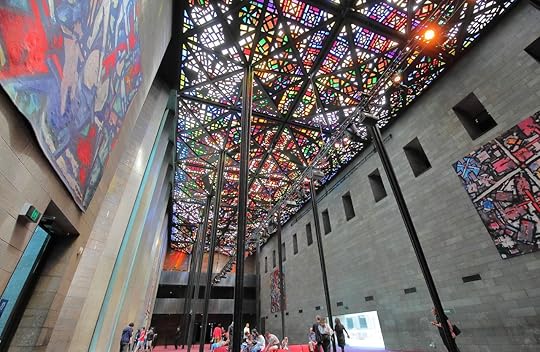
Photo: TK Kurikawa/Shutterstock
Melbourne’s National Gallery of Victoria is the oldest gallery in Australia and exists across two buildings, with more than 70,000 works in its collections. NGV celebrates a variety of art forms, from exhibitions of historic relics to fashion to architecture to dance. Its ceiling, however, is a masterpiece in its own right: It is the largest piece of suspended stained glass in the world, spanning the length of an entire hall. Its geometric shapes come together in a multitude of colors to resemble the sensation of looking through an oversized kaleidoscope.
6. Chicago Cultural Center — Chicago, Illinois

Photo: Rudy Balasko/Shutterstock
Not one but two oversized stained-glass domes top the Chicago Cultural Center, a landmark building of Chicago that was once a library but now functions as the city’s official reception center. The cultural center hosts hundreds of free, public events each year and is a popular Chicago spot, with attractions like free performing arts events, art exhibits, films, lectures, and more.
7. Printemps — Paris, France

Photo: Printemps/Facebook
Printemps, a luxe department store, takes up three buildings and 25 floors in central Paris. However, even those with no desire to shop or spend will enjoy a visit to this landmark; the beautiful architecture on the exterior gives way to a mind-blowingly intricate glass-dome ceiling inside. For more Parisian stained-glass ceiling goodness, pay a visit to the Galeries Lafayette, an upscale chain of department stores. The flagship location is often photographed for its impressive ceiling and the multi-story Christmas tree that’s erected in the center of it each year.
8. Old Louisiana State Capitol — Baton Rouge, Louisiana

Photo: Louisiana’s Old State Capitol/Facebook
The glass-dome ceiling inside Baton Rouge’s Old Louisiana State Capitol is an explosion of colors and dates back to the 1880s. Due to its design, the Old Louisiana State Capitol is sometimes referred to as the castle of Louisiana. Mark Twain famously wrote of his distaste for the castle-like building, calling it “pathetic,” but one look at the stained glass ceiling inside and most visitors agree it’s anything but.
9. British Museum — London, United Kingdom

Photo: Alex Segre/Shutterstock
The British Museum houses priceless artifacts, such as the Rosetta Stone and the Parthenon sculptures. You can spend hours wandering through the many galleries, looking at relics that make up some of the most treasured possessions of collective humanity. But as you explore the amazing sights, don’t forget to leave a few minutes to admire the iconic domed lattice glass ceiling covering the two-acre Great Court. It’s made of 3,312 panes of glass and, at the center, the Reading Room is encircled by a wide staircase, functioning as a grand entrance to all that the museum holds.
10. Children’s World (Detsky Mir) — Moscow, Russia

Photo: Belikart/Shutterstock
Moscow’s Children’s World, or Detsky Mir, was once the largest toy store in Europe. It underwent a major renovation, reopening its doors in 2014, and remains the largest toy store in Russia; however, it now also functions as a multi-purpose shopping center with stores of all sorts. The massive children’s store is topped with a skylight that spans an open, multi-storied central area where families can gather and enjoy a moment of peace before continuing on with the fun.
11. Brookfield Place — Toronto, Canada

Photo: Kiev.Victor/Shutterstock
Toronto’s Brookfield Place is a large downtown complex housing 49 stories of offices, but even tourists to Toronto will want to pay a visit. Inside the Allen Lambert Galleria on the ground floor, a highlight of the building, the ceiling is an attraction in its own right. Pedestrians in the elongated thoroughfare feel as if they’ve stepped inside a post-modern, tree-lined street. The ceiling reaches six stories high and functions like a vaulted, arched skylight. During the holidays, the complex showcases a wonderful display of lights attached to the gorgeous ceiling. 

More like this: The 9 most stunning stained-glass windows around the world
The post The 11 most beautiful glass ceilings around the world appeared first on Matador Network.

Whey premium economy is worth it

While so much of the travel experience is sliced up and targeted to specific market segments, air travel generally isn’t. Accommodations can range from hostels and mid-range Airbnbs to boutique inns and five-star hotels. But when it comes to booking international flights, the options have been to either to save money in coach class or spend it like there’s no tomorrow at the front of the aircraft.
OK, not everyone seated in business class — where a round-trip San Francisco to London booking can cost up to 12 times more than a seat in a coach — has money to burn. (The money-to-burn folks are in first class, anyway.) Plenty of biz-class passengers are executives whose companies are footing the bill, while others have used frequent traveler miles to upgrade their way into that cabin. But the differential in price and service between economy and business is a veritable chasm.
There is, however, another option. If your company isn’t paying the fare and you don’t have the airline status for an upgrade, but you are willing to pay a bit more to avoid a soul-crushing check-in line or a knee-crushing coach seat, there’s an emerging class of service for you — and it’s appearing on more and more long-haul routes and airlines: premium economy.
Streamlined check-in and slightly wider seats
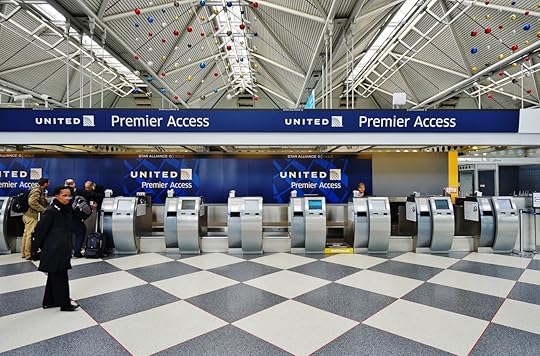
Photo: EQRoy/Shutterstock
Premium economy, as the name suggests, is closer to coach than business. There’s no Champagne before take-off or lie-flat beds (or anything close to lie-flat), but you will get a more streamlined check-in experience, an amenities kit, and a bit more space to stretch out. You’ll also get a smaller cabin with more attentive service and, on some airlines, better food and free drinks.
Depending on the route, airline, and time of year, premium economy costs between two and three times more than a regular economy ticket. While well below business fares, it’s still a hefty cost difference, which is why some airlines tout is as an option when traveling for a special occasion, such as a birthday or honeymoon.
At least that’s how United Airlines has promoted its recently inaugurated Premium Plus service, which kicked off in March of this year.
Flying on United Airlines’ Premium Plus

Photo: Noelle Alejandra Salmi
Last month, I was celebrating neither a birthday nor a honeymoon, but I did get to fly on United’s Premium Plus service from San Francisco to Auckland, New Zealand. Even coach flights to New Zealand aren’t cheap, coming in between $1,200 and $1,700 round-trip, and Premium Plus tickets tend to be a little more than double that.
The Premium Plus cabin was separated from the economy cabin in color (purple versus blue), location (sandwiched between business and economy), and seat style (two inches wider at 19 inches, with a tad more recline). We had three rows of seats in a two-four-two configuration, so the cabin fit just 24 passengers.
We were far fewer than 24 travelers, though, and I had the window and aisle to myself. A silver-haired couple from San Luis Obispo, California, were seated in the middle and had the four seats to themselves. They’d booked it for their return to New Zealand after honeymooning there many years earlier.
“This is a strange world. It’s not quite coach,” said Susan Andros. When she and her husband first traveled to New Zealand, Susan said they had flown in economy class. Thirty-eight years later, they wanted a bit of an upgrade. “This feel like domestic first class,” said Susan.
In fact, United’s domestic first class seats are usually wider, at 20.5 inches, but the amount of pitch — or distance between the seats — in Premium Plus was a generous 38 inches. That’s similar to most of UA’s domestic first class.
What you get in premium economy

Photo: Noelle Alejandra Salmi
Specifically, United defines its international Premium Plus offerings as added convenience (with Premier check-in access and guaranteed overhead bin space), more spacious seating, upgraded dining service (with free alcoholic beverages and dinner served on nicer dinnerware with cloth napkins), and improved entertainment (with bigger screens and noise-reducing headphones). Add to that plush pillows, blankets, and an amenity kit, and it is certainly a cut above.
I really appreciated the smaller cabin size, the more attentive service, and meals that felt more special. The only disappointment was in the seats themselves; they were pretty firm, and the six inches of recline was less than I’d hoped. Since, as in business class, the tray table tucks into the armrest, you can’t raise said armrest — so I couldn’t take advantage of having the two seats by myself to stretch out.
Comparisons across the Pacific

Photo: Qantas
United’s service is pretty similar to that of other US carriers, but it stacks up a little differently from carriers serving the Oceania route. On that same SFO-Auckland routing, Air New Zealand’s premium economy cabins is one of the best anywhere. You’ll likely pay an additional two hundred dollars more round trip than on United, but the food is served from those elegant business-class carts, and the seats are really comfortable. Although they’re about the same 19-inch width, they’re padded, offer nearly three more inches of recline, and have a more usable footrest. It’s just enough to allow for better sleep.
Also servicing routes across the Pacific Ocean, Qantas was early into the premier economy game and does it well. Although the plush seats are just 19.5 inches wide, there’s far more space between seats. Price-wise, though, Qantas’s premium economy is more expensive relative to economy — running at nearly three times the cost.
Other US carriers
Like United, American Airlines’ and Delta’s premium economy services offers 19-inch-wide seats (actually, Delta’s are 18.5 inches) with lots of legroom, amenity kits, free alcoholic beverages, and meals served on fancier plate ware.
All of the cabins feel more private, but the placing of the restroom relative to the premium economy cabin depends on the aircraft. Technically, premium economy customers are supposed to use the economy restroom — and it can sometimes feel far away. American’s gray color scheme is somewhat drab, but the seats have slightly more cushion. Delta’s seats give you more inches of recline, and the TUMI amenity bags are a nice touch.
Comps across the Atlantic

Photo: Sorbis/Shutterstock
British Airways World Traveller Plus, which I’ve taken a few times, has seats similar in width to UA’s, but the service is more attentive. Particularly appealing is the table-clothed cart that’s set up with fruit and snack baskets for noshing in between meals. Another big difference is the seat recline, which is substantial. This can be problematic if you need to work on your laptop while your forward neighbor dozes; you’ll fear crunching your computer. But if your goal is sleep, you’ll really notice and appreciate the difference.
Lufthansa has very comfortable seats, good food, and excellent service. Air France’s premium economy also gets high marks for service, including check-in at the business-class counter, but the firm seats that hardly recline are a major let-down. Reviewers wonder if the Air France designers actually tried to sleep in them.
Is it worth it?

Photo: Maridav/Shutterstock
Depending on your budget and your priorities, premium economy service is worth considering. On some airlines, you could try to use miles to get into this cabin. For now, that’s a non-starter on United — where you need almost as many miles for Premium Plus as for business. A one-way ticket on United from San Francisco to Auckland was 40K miles for an economy seat, a whopping 170K for Premium Plus, and 200K miles for business.
Whether you opt to shell out the extra cash should depend on the circumstances of your trip. If you’re flying back on a day flight from Paris to New York, premium economy is probably not worth the extra cost. If you’re flying on the nearly 13-hour redeye from Los Angeles to Auckland, the extra cash outlay may be worth it.
After all, those flights arrive early in the morning. Chances are you can’t check into your hotel or Airbnb at 8:00 AM, so you’ll have to just start exploring. If you’ve spent a sleepless night in coach, you may not be ready to head up Auckland’s Sky Tower for sweeping views of this waterfront city or go out for a sail in an America’s Cup boat.
I was, in fact, able to do those lovely things as soon as we landed in Auckland with a reasonable amount of energy, because I had gotten some sleep — even if the seats could have been more comfortable. The cabin was quiet, and the extra space did allow for a few hours of shuteye.
Susan Andros, the passenger returning to New Zealand after 38 years, was quite satisfied with United’s Premium Plus. She said it was very comfortable. The extra sleep meant that on arrival in New Zealand, she and her husband could “hit the ground running.”
When time is money, not losing a day of your vacation to exhaustion caused by lack of sleep is worth something. For some, it’s priceless. For others, it may be just enough to justify that premium-economy price tag. 

More like this: How to use the science of routine to beat jet lag
The post Why flying in premium economy may be worth the extra splurge appeared first on Matador Network.

Traditional cassava dishes in Brazil

Brazil is a vast country with jungles the size of small countries and a coastline that seems to go on infinitely. The food varies as widely as the landscape, each region specializing in its own dishes. Regional flavors overlap, like the fresh coconuts that are sold the length of the coast and the rice and beans eaten countrywide. Tropical touches, sweet desserts and candies, food that evokes centuries of international influence, and wild colors and shapes all scream Brazil.
When it comes to what the country eats, Brazil is a carnivore-friendly country, from São Paulo to Salvador. Vegetables are not always an important component of a dish with one exception: mandioca, or cassava. Or macaxeira, aipim, manioc, yuca (though not yucca) — the names are endless. Brazilians love this root vegetable, and many legends tell stories of cassava, naming it a savior against starvation. The Portuguese and Spanish spread the indigeous Brazilian crop to Africa and the tropics where it now accounts for a significant portion of the diet.

Photo: Julio Ricco/Shutterstock
Cassava has many benefits; it’s highly adaptable and can grow in drought regions. It’s carb-heavy and nutritious, and it’s the third-largest source of carbohydrates in the world for humans. Plus it’s gluten-free. Proper preparation is key as cassava contains the poison cyanide to protect it against parasites and diseases. Removing the poison can be done by peeling the cassava, then soaking, cooking, or fermenting it to eliminate risks.
Cassava is not especially appealing by purely physical characteristics, but the flavors that lie under its thick skin come alive through a number of versatile preparations. Cassava is often boiled, fried, or toasted, and it’s served both savory and sweet. It can be sprinkled on other foods as seasoning, or it can be the star of the dish.
Be it a spontaneous trip to Brazil for some beachfront cassava fries or a visit to a tropical restaurant, you will not be disappointed with the flavors you discover. Nutritionally dense and easily adaptable, cassava has played a large role in diets across tropical countries. When the time for a journey to Brazil is right (which is now, for US travelers who no longer need a visa for a visit), you’ll see that an authentic culinary experience undoubtedly involve cassava.
The best cassava dishes in Brazil
1. Cassava fries

Photo: Carla Nichiata/Shutterstock
Not to be confused with the potato variety, cassava fries have a crunchier texture — making them extra hard to resist. The taste is lightly sweet and similar to French fries, and Brazil’s cassava fries are similar to the yucca fries served in Cuba and other Caribbean islands. The fries can be had as a snack at a beachfront shack or served as a side for a main dish. While the carb-rich snack isn’t exactly healthy, it’s always a good time for cassava fries.
2. Farofa

Photo: jessicacaires/Shutterstock
Farofa is a gluten-free cassava flour that’s toasted in a pan with oil, spices, and sometimes additional ingredients like chopped vegetables or meat. It has a similar appearance and texture to seasoned breadcrumbs and is typically sprinkled on a dish to season and add texture but can also be eaten alone. Each region has its own blend of seasoning, always considered the very best version by their locals.
3. Tapiocas

Photo: Marcelo_Krelling/Shutterstock
Brazil’s answer to crepes and tacos is the popular street food tapioca, made from the starch of the cassava root. It’s first moistened and passed through a sieve as a coarse flour, then sprinkled on a hot pan. The heat makes the starch bind together, resulting in a grainy flatbread. It can be buttered for breakfast like pancakes or filled with sweet or savory ingredients as a snack. Some favorites toppings are carne do sol (sun-cured meat) and Romeu e Julieta (guava paste and cheese). A Brazilian tapioca that could also swap in as dessert is one that comes filled with a sweet coconut mix.
4. Pirão

Photo: Paulo Vilela/Shutterstock
Often an accompaniment for seafood dishes in the north, pirão is a porridge-like substance made from cassava flour and broth. Generally, seafood broth is used, and the puree is served alongside shrimp or fish. Although the thick texture can be off-putting for some, the flavors from the broth provide a nice complement to many dishes.
5. Pão de queijo

Photo: rocharibeiro/Shutterstock
One of Brazil’s most famous snacks is pão de queijo, which translates literally to cheese bread. Cassava flour and cheese are the main ingredients of these little rolls, which vary in size, flavor, and texture around the country. Generally eaten for breakfast or as a snack with coffee, pão de queijo can be found sold at street corners. Pão de queijo is so ubiquitous, you’ll even find it in Brazil’s local Starbucks cafes. The cassava flour makes this unleavened bread somewhat elastic, setting it apart from wheat bread. 

More like this: 8 sweet, fruity, and savory Brazilian desserts you need in your life
The post 5 delicious ways to use cassava, Brazil’s most versatile food appeared first on Matador Network.

Black bear cub killed in Oregon

On Thursday, a young black bear was killed by Oregon state officials because the bear had become too comfortable around humans. It wasn’t the bear’s fault, though. People frequently fed the animal so it would come close enough for a selfie, so unsurprisingly, the bear often came within close proximity of humans. Most recently, the bear was seen near tourists at Scoggins Valley Park in Washington County, prompting two people to call the sheriff’s office out of concern.
The bear is believed to have been fed often by humans visiting the area, particularly via boat. He has been seen eating trail mix, sunflower seeds, and cracked corn apparently left intentionally by park visitors, and it was observed that he hardly flinched when humans approached.
Kurt License, a wildlife biologist, said, “It was very clear that the animal was way too habituated. With that information, it was a human health and safety risk, and we had to remove it.”
On Wednesday, authorities had urged the public via Twitter to stay clear of the area. “Deputies are working to get this bear cub near Hagg Lake to go back into the woods,” they said. “Please stay away from the area near Boat Ramp A.” However, on Friday the WSCO Oregon Twitter account announced that the bear had been killed.
Unfortunately, yes. This was a tough decision the wildlife experts at the Oregon Dept. of Fish & Wildlife had to make for the safety of everyone. Relocation wasn't an option in this case. Humans shouldn't feed wild bears. It's a very sad situation.
— WCSO Oregon (@WCSOOregon) June 14, 2019
Unsurprisingly, people are outraged and taking to Twitter to express their disgust with the killing. 
Yeah, so killing it was the only option??? Next excuse please because that’s fucking garbage….
— Stefan Pursell (@StefanPursell) June 14, 2019
Why was relocation not an option? It couldn't have been taken to a zoo or wildlife reserve? Why did killing him have to be the only solution? This is such a disgusting thing …
— Chris Elizondo (@Chelipepper_) June 18, 2019
This wasn't a "tough decision". This was a reckless and a very bad decision made by LAZY people. We have the power and the means to relocate this bear to another state, isolated forested area, or sanctuary. This bear did not have to be "euthanized". I bet you guys (1/?)
— Joe G. (@clipperjoe9972) June 18, 2019
H/T: Insider

More like this: Forget whale watching. Bear watching is our new favorite activity
The post Black bear cub in Oregon killed because people kept feeding it, and it had become ‘too comfortable’ around humans appeared first on Matador Network.

Russian trans-Arctic Zarengold train

The Trans-Siberian Railway might be Russia’s best-known train route, but soon it might take a backseat to this epic 900-mile rail ride to Norway. The Moscow to Oslo trip aboard the Zarengold (meaning “Tsars’ Gold”) made its debut last week, and it’s the only route through the Russian Arctic via private train.
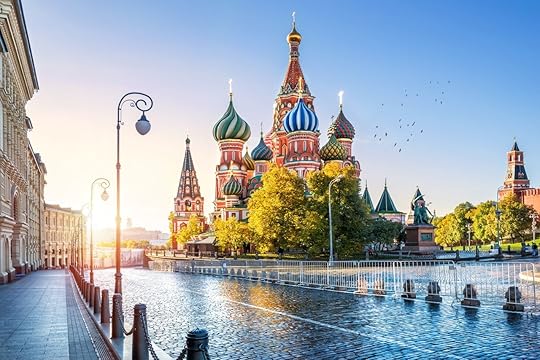
Photo: Baturina Yuliya/Shutterstock
The journey begins with a tour of Moscow, then continues by express train to St. Petersburg for a few days of sightseeing. Then, you’ll board the Zarengold to the city of Petrozavodsk and Kizhi Island, a UNESCO World Heritage site, home to two impressive wooden churches and an octagonal clock tower. Passengers will then head to Murmansk, the largest Arctic city in the world. From Murmansk, you will continue on to Kiekenes over the border of Norway, and then fly to Oslo the following day.

Photo: jejim/Shutterstock
The Zarengold is not your average commuter — you’ll be treated to gourmet feasts, vodka testing, and comfy compartments to see the Land of the Midnight Sun in style.

Photo: Lernidee Trains & Cruises/Facebook
Two trains are scheduled to make the journey in May and June 2020 — one from Moscow to Norway, and one the other way around. The tour lasts a total of eleven days and costs about $4,000 per person, including accommodation, internal flights, meals, excursions, and, of course, train tickets.
More information about the train, and booking, can be found on the Lernidee Trains & Cruises website. 
H/T: Lonely Planet

More like this: 7 amazing Russian churches that seem right out of a fairytale
The post The Zarengold is Russia’s real-life Polar Express appeared first on Matador Network.

Taj Mahal to fine tourists for late

If you’re planning a trip to India to visit the Taj Mahal, you’re going to want to master the art of efficiency first. Taj Mahal authorities will soon begin charging tourists who linger for more than three hours in order to combat the negative effects of overcrowding at the popular site. Last year, authorities limited the number of daily visitors and raised the entry fee dramatically, and this new regulation is designed to facilitate a smooth, manageable flow of visitors.
To track visitors entering and exiting the Taj Mahal, turnstile gates have been installed at the entry points, so authorities can more easily monitor how long people are spending at the attraction and manage the crowds. Vasant Swarakar, the superintending archaeologist, told The Times of India, “If tourists exceed their time limit of three hours, they will be charged an extra amount equivalent to the ticket, which will have to be paid at the exit gate. Entry time will also be enforced and if tourists don’t arrive at the slotted time, they will not be allowed entry and will have to buy a new ticket.”
Three hours seems like a pretty reasonable amount of time to view the attraction in its entirety, and, of course, there are ways to admire the wonderful exterior away from the crowds that allow smitten visitors to take it all in. 

More like this: 4 alternatives to see the Taj Mahal away from the crowds
The post The Taj Mahal will start charging tourists for staying over three hours appeared first on Matador Network.

Harry Potter cafe opens in New York

In case you were worried that the fervor surrounding the Harry Potter series was dying down, 12 years after the publication of the final book, rest easy — the Potter mania is still going strong. The proof is in the butterbeer served up at the Harry Potter-inspired cafe located in New York City’s East Village.
Steamy Hallows will make you feel like you’ve stepped off Platform 9 and ¾ and right into Diagon Alley. According to Steamy Hallows’ Instagram, the cafe is a “witchy goth coffee shop [that] serves up delicious coffee and tea portions and homemade cookies in an immersive environment.”
View this post on InstagramA post shared by Steamyhallows (@steamyhallows) on May 29, 2019 at 11:28am PDT
Inspired by both Harry Potter and Halloween, the cafe features floating candles — reminiscent of Hogwarts’ Great Hall — broomsticks, a smoking cauldron, Harry Potter mirrors, and menu items like Love Potion 9 ¾, Basic Witch, El Diablo, and of course, Butterbeer (which can be made even better with coffee for those who can’t fight their caffeine addiction). Some of the drinks at Steamy Hallows are even topped with edible glitter, to add a particularly magical touch.
View this post on InstagramA post shared by Steamyhallows (@steamyhallows) on May 23, 2019 at 1:49pm PDT
Steamy Hallows is located at 514 ¾ East Sixth Street, though despite its dark, gotch aesthetic, it’s only open until 7:00 PM. 

More like this: 18 real-life places every Harry Potter fan needs to visit
The post There’s a ‘Harry Potter’ cafe in NYC and it’s absolutely magical appeared first on Matador Network.

Matador Network's Blog
- Matador Network's profile
- 6 followers



